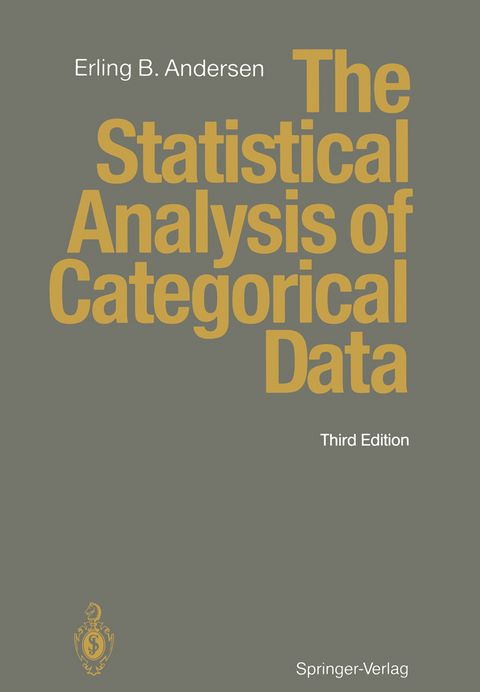
The Statistical Analysis of Categorical Data
Springer Berlin (Verlag)
9783642788192 (ISBN)
The book introduces readers to the latest developments in categorical data analysis. It shows how real life data can be analysed, how conclusions are drawn and how models are modified.
1. Categorical Data.- 2. Preliminaries.- 2.1 Statistical models.- 2.2 Estimation.- 2.3 Testing statistical hypotheses.- 2.4 Checking the model.- 3. Statistical Inference.- 3.1 Log-linear models.- 3.2 The one-dimensional case.- 3.3 The multi-dimensional case.- 3.4 Testing composite hypotheses.- 3.5 The parametric multinomial distribution.- 3.6 Generalized linear models.- 3.7 Solution of likelihood equations.- 3.8 Exercises.- 4. Two-way Contingency Tables.- 4.1 Three models.- 4.2 The 2×2 table.- 4.3 The log-linear parameterization.- 4.4 The hypothesis of no interaction.- 4.5 Residual analysis.- 4.6 Exercises.- 5. Three-way Contingency Tables.- 5.1 The log-linear parameterization.- 5.2 Hypothesis in a three-way table.- 5.3 Hypothesis testing.- 5.4 Decomposition of the test statistic.- 5.5 Detection of model departures.- 5.6 Exercises.- 6. Multi-dimension Contingency Tables.- 6.1 The log-linear model.- 6.2 Interpretation of log-linear models.- 6.3 Search for a model.- 6.4 Diagnostics for model departures.- 6.5 Exercises.- 7. Incomplete Tables, Separability and Collapsibility.- 7.1 Incomplete tables.- 7.2 Two-way tables and quasi-independence.- 7.3 Higher order tables. Separability.- 7.4 Collapsibility.- 7.5 Exercises.- 8. The Logit Model.- 8.1 The logit-model with binary explanatory variables.- 8.2 The logit model with polytomous explanatory variables.- 8.3 Exercises.- 9. Logistic Regression Analysis.- 9.1 The logistic regression model.- 9.2 Regression diagnostics.- 9.3 Predictions.- 9.4 Polytomous response variables.- 9.5 Exercises.- 10. Models for the Interactions.- 10.1 Introduction.- 10.2 Symmetry models.- 10.3 Marginal homogeneity.- 10.4 Models for mobility tables.- 10.5 Association models.- 10.6 RC-association models.- 10.7 Log-linear association models.- 10.8 Exercises.- 11. Correspondence Analysis.- 11.1 Correspondence analysis for two-way tables.- 11.2 Correspondence analysis for multi-way tables.- 11.3 Comparison of models.- 11.4 Exercises.- 12. Latent Structure Analysis.- 12.1 Latent structure models.- 12.2 Latent class models.- 12.3 Continuous latent structure models.- 12.4 The EM-algorithm.- 12.5 Estimation in the latent class model.- 12.6 Estimation in the continuous latent structure model.- 12.7 Testing the goodness of fit.- 12.8 Diagnostics.- 12.9 Score models with varying discriminating powers.- 12.10 Comparison of latent structure models.- 12.11 Estimation of the latent variable.- 12.12 Exercises.- 13. Computer Programs.- References.- Author Index.- Examples with Data.
| Erscheint lt. Verlag | 13.12.2011 |
|---|---|
| Zusatzinfo | XII, 532 p. |
| Verlagsort | Berlin |
| Sprache | englisch |
| Maße | 170 x 244 mm |
| Gewicht | 933 g |
| Themenwelt | Mathematik / Informatik ► Mathematik ► Statistik |
| Mathematik / Informatik ► Mathematik ► Wahrscheinlichkeit / Kombinatorik | |
| Wirtschaft ► Allgemeines / Lexika | |
| Wirtschaft ► Volkswirtschaftslehre | |
| Schlagworte | Calculus • Economics • Modeling • Regression • Regression Analysis • Statistical Analysis • Statistical Inference • Statistical Models |
| ISBN-13 | 9783642788192 / 9783642788192 |
| Zustand | Neuware |
| Informationen gemäß Produktsicherheitsverordnung (GPSR) | |
| Haben Sie eine Frage zum Produkt? |
aus dem Bereich


